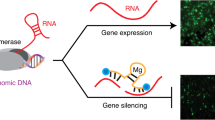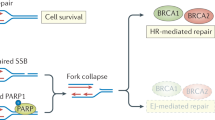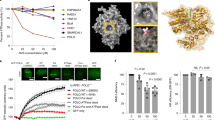Abstract
Overexpression of P-glycoprotein, encoded by the MDR1 gene, confers multidrug resistance (MDR) on cancer cells and is a frequent impediment to successful chemotherapy. Recent developments in the use of small interfering RNAs to inhibit specific protein expression have highlighted their potential use as therapeutic agents. We have expressed two different short hairpin RNAs from stably integrated plasmids in doxorubicin-resistant K562 leukaemic cells. The MDR1-targeted RNA interference (RNAi) resulted in decreased MDR1 mRNA, abolished P-glycoprotein expression, and completely reversed the MDR phenotype to that of the drug-sensitive K562 parental line. This study demonstrates that MDR, which is solely due to overexpression of P-glycoprotein, can be reversed by RNAi. These target sequences can in the future be integrated into gene therapy vectors with potential clinical application.
This is a preview of subscription content, access via your institution
Access options
Subscribe to this journal
Receive 12 print issues and online access
$259.00 per year
only $21.58 per issue
Buy this article
- Purchase on Springer Link
- Instant access to full article PDF
Prices may be subject to local taxes which are calculated during checkout





Similar content being viewed by others
References
Gottesman MM, Fojo T, Bates SE . Multidrug resistance in cancer: role of ATP-dependent transporters. Nat Rev Cancer 2002; 2: 48–58.
Jin S, Gorfajn B, Faircloth G, Scotto KW . Ecteinascidin 743, a transcription-targeted chemotherapeutic that inhibits MDR1 activation. Proc Natl Acad Sci USA 2000; 97: 6775–6779.
Synold TW, Dussault I, Forman BM . The orphan nuclear receptor SXR coordinately regulates drug metabolism and efflux. Nat Med 2001; 7: 584–590.
Yang JM, Vassil AD, Hait WN . Activation of phospholipase C induces the expression of the multidrug resistance (MDR1) gene through the Raf–MAPK pathway. Mol Pharmacol 2001; 60: 674–680.
Cucco C, Calabretta B . In vitro and in vivo reversal of multidrug resistance in a human leukaemia-resistant cell line by mdr1 antisense oligodeoxynucleotides. Cancer Res 1996; 56: 4332–4337.
Marthinet E et al. Modulation of the typical multidrug resistance phenotype by targeting the MED-1 region of human MDR1 promoter. Gene Therapy 2000; 7: 1224–1233.
Wang FS et al. Retrovirus-mediated transfer of anti-MDR1 ribozymes fully restores chemosensitivity of P-glycoprotein-expressing human lymphoma cells. Hum Gene Ther 1999; 10: 1185–1195.
Hannon GJ . RNA interference. Nature 2002; 418: 244–251.
Elbashir SM, Lendeckel W, Tuschl T . RNA interference is mediated by 21- and 22-nucleotide RNAs. Genes Dev 2001; 15: 188–200.
Brummelkamp TR, Bernards R, Agami R . A system for stable expression of short interfering RNAs in mammalian cells. Science 2002; 296: 550–553.
An DS et al. Efficient lentiviral vectors for short hairpin RNA delivery into human cells. Hum Gene Ther 2003; 14: 1207–1212.
Wu H, Hait WN, Yang JM . Small interfering RNA-induced suppression of MDR1 (P-glycoprotein) restores sensitivity to multidrug-resistant cancer cells. Cancer Res 2003; 63: 1515–1519.
Nieth C, Priebsch A, Stege A, Lage H . Modulation of the classical multidrug resistance (MDR) phenotype by RNA interference (RNAi). FEBS Lett 2003; 545: 144–150.
Batist G et al. Overexpression of a novel anionic glutathione transferase in multidrug-resistant human breast cancer cells. J Biol Chem 1986; 261: 15544–15549.
Lage H, Dietel M . Multiple mechanisms confer different drug-resistant phenotypes in pancreatic carcinoma cells. J Cancer Res Clin Oncol 2002; 128: 349–357.
Mechetner E et al. Levels of multidrug resistance (MDR1) P-glycoprotein expression by human breast cancer correlate with in vitro resistance to taxol and doxorubicin. Clin Cancer Res 1998; 4: 389–398.
Muller C, Laurent G, Ling V . P-glycoprotein stability is affected by serum deprivation and high cell density in multidrug-resistant cells. J Cell Physiol 1995; 163: 538–544.
Frost BM et al. Pharmacokinetics of doxorubicin in children with acute lymphoblastic leukaemia: multi-institutional collaborative study. Med Pediatr Oncol 2002; 38: 329–337.
Yague E et al. P-glycoprotein (MDR1) expression in leukaemic cells is regulated at two distinct steps, mRNA stabilization and translational initiation. J Biol Chem 2003; 278: 10344–10352.
Yu JY, DeRuiter SL, Turner DL . RNA interference by expression of short-interfering RNAs and hairpin RNAs in mammalian cells. Proc Natl Acad Sci USA 2002; 99: 6047–6052.
Hemann MT et al. An epi-allelic series of p53 hypomorphs created by stable RNAi produces distinct tumor phenotypes in vivo. Nat Genet 2003; 33: 396–400.
Chi JT et al. Genomewide view of gene silencing by small interfering RNAs. Proc Natl Acad Sci USA 2003; 100: 6343–6346.
Uptain SM, Kane CM, Chamberlin MJ . Basic mechanisms of transcript elongation and its regulation. Annu Rev Biochem 1997; 66: 117–172.
Ramachandran C, Wellham LL . Effect of MDR1 phosphorothioate antisense oligodeoxynucleotides in multidrug-resistant human tumor cell lines and xenografts. Anticancer Res 2003; 23: 2681–2690.
Abbas-Terki T et al. Lentiviral-mediated RNA interference. Hum Gene Ther 2002; 13: 2197–2201.
Rubinson DA et al. A lentivirus-based system to functionally silence genes in primary mammalian cells, stem cells and transgenic mice by RNA interference. Nat Genet 2003; 33: 401–406.
Stewart SA et al. Lentivirus-delivered stable gene silencing by RNAi in primary cells. Rna 2003; 9: 493–501.
Ivy SP et al. Correlation of P-glycoprotein expression and function in childhood acute leukaemia: a children's cancer group study. Blood 1996; 88: 309–318.
McKenna SL, Padua RA . Multidrug resistance in leukaemia. Br J Haematol 1997; 96: 659–674.
Melo JV, Hughes TP, Apperley JF . Chronic myeloid leukaemia. Hematology (Am Soc Hematol Educ Program) 2003: 132–152.
O'Dwyer ME, Mauro MJ, Druker BJ . Recent advancements in the treatment of chronic myelogenous leukaemia. Annu Rev Med 2002; 53: 369–381.
Goldman JM, Melo JV . Chronic myeloid leukaemia–advances in biology and new approaches to treatment. N Engl J Med 2003; 349: 1451–1464.
Paterson SC, Smith KD, Holyoake TL, Jorgensen HG . Is there a cloud in the silver lining for imatinib? Br J Cancer 2003; 88: 983–987.
Mahon FX et al. MDR1 gene overexpression confers resistance to imatinib mesylate in leukaemia cell line models. Blood 2003; 101: 2368–2373.
Wohlbold L et al. Inhibition of bcr-abl gene expression by small interfering RNA sensitizes for imatinib mesylate (STI571). Blood 2003; 102: 2236–2239.
Damm-Welk C, Fuchs U, Wossmann W, Borkhardt A . Targeting oncogenic fusion genes in leukaemias and lymphomas by RNA interference. Semin Cancer Biol 2003; 13: 283–292.
Tipping AJ, Deininger MW, Goldman JM, Melo JV . Comparative gene expression profile of chronic myeloid leukaemia cells innately resistant to imatinib mesylate. Exp Hematol 2003; 31: 1073–1080.
Agami R, Bernards R . Distinct initiation and maintenance mechanisms cooperate to induce G1 cell cycle arrest in response to DNA damage. Cell 2000; 102: 55–66.
Acknowledgements
This work was supported by the Medical Research Council UK. We thank Ms Katie Smith for assistance with flow cytometry.
Author information
Authors and Affiliations
Rights and permissions
About this article
Cite this article
Yagüe, E., Higgins, C. & Raguz, S. Complete reversal of multidrug resistance by stable expression of small interfering RNAs targeting MDR1. Gene Ther 11, 1170–1174 (2004). https://doi.org/10.1038/sj.gt.3302269
Received:
Accepted:
Published:
Issue Date:
DOI: https://doi.org/10.1038/sj.gt.3302269
Keywords
This article is cited by
-
Effects of ABCG2 C421A and ABCG2 G34A genetic polymorphisms on clinical outcome and response to imatinib mesylate, in Iranian chronic myeloid leukemia patients
Egyptian Journal of Medical Human Genetics (2023)
-
Oncolytic virotherapy reverses chemoresistance in osteosarcoma by suppressing MDR1 expression
Cancer Chemotherapy and Pharmacology (2021)
-
Exosomal microRNAs derived from mesenchymal stem cells: cell-to-cell messages
Cell Communication and Signaling (2020)
-
Combination of siRNA-directed Gene Silencing With Cisplatin Reverses Drug Resistance in Human Non-small Cell Lung Cancer
Molecular Therapy - Nucleic Acids (2013)
-
Reversal of ATP-binding cassette drug transporter activity to modulate chemoresistance: why has it failed to provide clinical benefit?
Cancer and Metastasis Reviews (2013)



